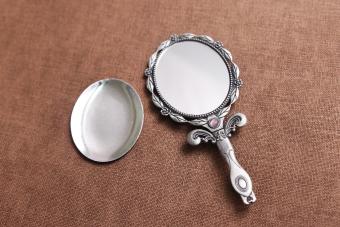
Antique mirrors come in a variety of shapes, sizes, and mirror styles. Explore the different types of antique mirrors and their original purposes along with popular antique mirror styles throughout history. You can use this list of mirror types and styles to help identify an antique mirror you own or decide which kind you want to purchase.
Types of Antique Mirrors
An antique mirror is any mirror made at least 100 years ago. Modern designers sometimes make mirrors that look antique because the look of old mirrors never goes out of style. From decorative mirrors to functional mirrors, there are several types of antique mirrors in the world.
Antique Dressing Mirror or Floor Mirror
Antique floor mirrors, also known as standing mirrors or dressing mirrors, didn't really come onto the market until the 1700s when new processes made it possible to produce larger mirrors. They are tall mirrors that stand alone on the ground so you can see most or all of your body at once.
- In the late 1700s, these dressing mirrors were first made to be freestanding.
- The earliest free standing mirrors were made from silver or silver gilt.
- The cheval mirror is a standing dressing mirror first made in Paris in the 1800s. It was made in either an oval or rectangular shape and supported by four legs.

Antique Handheld Mirror
Hand mirrors were made in ancient societies such as Mesopotamia, Egypt, and China where they were forged out of reflective metals. Later, other types of mirrors were used. But, handheld mirrors are called as such because, no matter what type of reflective surface was used, it was small and attached to an adorned handle.
- The earliest glass coated handheld mirrors were made in a part of what is now Lebanon in the first century A.D. and were only about 3 inches in diameter.
- In the 1800s, antique mirror and brush sets were on trend for Victorian women.
- Hand mirrors with hand-painted porcelain backs were popular in France and Germany in the late 1800s.

Antique Toilet Mirror
A toilet mirror was made to stand upright on a table as more of a decoration than a tool. These were widely produced in the late 1600s and by the early 1700s they had evolved to include a base that featured small drawers.
Antique Vanity Tray Mirror
Also known as a dresser tray, perfume tray, or mirrored plateau, an antique vanity mirror tray is a small tray with a mirrored surface that was meant to hold and display a woman's fine perfumes. These were popular during Victorian times. These trays were also used showcase a centerpiece on the dining room table centuries ago.
Antique Wall Mirror
Wall mirrors are any mirrors designed to hang on the wall. They come in a variety of shapes, sizes, and materials. Larger and decorative mirrors, like wall mirrors, didn't come onto the market until the late 1700s.
Antique Mirror Styles
Throughout history, each type of mirror was customized to the trending design style of that period. A look at different antique mirror styles helps you determine what era the mirror was made during.
Baroque Style Mirrors
The Baroque style is from the 17th century and used gold or silver gilding. Ebony or tortoiseshell inlays and carvings of fruits, angels, flowers, and leaves were popular during this time.
Georgian Style Mirrors
The Georgian era took place in Britain from about 1714 to 1830. This style is marked by its lack of elaborate carvings except along the top edge of the mirror frame. Designs during this time included scrolls, beading, and symmetry.

Gothic Style Mirrors
From the 12th to the 16th centuries, Gothic style mirrors resembled church windows. These oval mirrors framed in dark wood featured scrolling and carvings. These mirrors are marked by pointed arches at the top.
Neoclassical Style Mirrors
In the mid and late 1700s, the neoclassical style emerged using columns and medallion carvings around the top. You'll find neoclassical mirrors in rectangular and cathedral shapes with silver or gold gilded frames.
Regency Style Mirrors
Oval mirrors with thin frames were the style during the Regency period in the early 1800s. They are marked by columned frames, cornices, and flower or leaf designs.
Rococo or Late Baroque Style Mirrors
From 1730 to the early 1800s, the Rococo style was popular. This style is characterized by heavy sculpted plaster frames gilded in gold. Natural items like seashells, leaves, feathers, birds, and flowers were common. Rococo mirrors are most often rectangular or an oval shape with a flat bottom known as cathedral shape. It was common to have a painting on the back of these mirrors.

Types of Antique Mirror Glass
From polished stone and metals to backed glass, antique mirror glass has changed throughout history as much as the types and frame styles.
- The earliest mirrors made for centuries used polished metals like tin or copper rather than glass.
- Blown glass was used in Venice in the 1500s to create mirrors backed with mercury and tin, but they could only create small flat mirrors at that time.
- Ancient Roman mirror glass has a green tint because it included iron.
- In the late 1600s and early 1700s, the French improved upon the Venetian processes for making mirrors and invented a way to make larger sheets of glass.
- In 1835, the method of putting real silver on the backs of sheets of glass to make mirrors was invented in Germany.

A Look At Mirrors
Centuries ago, mirrors were almost as unique as their owners. The expensive nature of their production often meant only the wealthiest people owned mirrors. Today, you can use different types and styles of antique mirrors to decorate your home and pay homage to history.







